Is The Ankh A Christian Symbol? Examining Its Origins And Meanings
The ankh is an ancient Egyptian hieroglyph representing life and fertility. Its iconic shape is familiar even to those unfamiliar with Egyptian history – a cross topped with a loop.
If you’re short on time, here’s a quick answer: The ankh originated in ancient Egyptian religion long before Christianity, so it is not inherently a Christian symbol. However, some Christians have adopted the ankh and ascribed Christian meanings to it.
Origins and Meaning in Ancient Egyptian Religion
The Ankh, a symbol commonly associated with ancient Egypt, holds deep religious and cultural significance. Its origins can be traced back to the ancient Egyptian religion, where it played a vital role in their beliefs and practices.
Used in Hieroglyphs and Art as Symbol of Life
The Ankh was prominently used in ancient Egyptian hieroglyphs and art as a symbol of life. Its distinctive shape, resembling a looped cross with a handle, represented the concept of eternal life and immortality.
The loop at the top symbolized the eternal soul, while the cross represented the physical body.
One interesting fact is that the Ankh was often depicted being held by gods and goddesses, signifying their ability to grant and sustain life. It was also frequently seen in the hands of pharaohs, emphasizing their divine authority and connection to the gods.
Many ancient Egyptian artifacts, such as amulets, jewelry, and tomb decorations, featured the Ankh as a powerful symbol of life and protection. It was believed to bring good fortune, health, and prosperity to those who wore or displayed it.
Associated with Egyptian Gods Like Osiris and Isis
In ancient Egyptian mythology, the Ankh was closely associated with prominent gods and goddesses. One of the most significant connections was with Osiris, the god of the afterlife and rebirth. The Ankh symbolized his power to grant eternal life to the deceased.
Another deity linked to the Ankh was Isis, the goddess of magic and fertility. She was often depicted holding the Ankh, representing her role as the giver of life and protector of the pharaohs.
The association of the Ankh with these powerful deities further solidified its importance in ancient Egyptian religion and culture.
Given to Pharaohs and Common People in Burials
The Ankh held such significance in ancient Egyptian society that it was frequently placed in the tombs of both pharaohs and common people. It was believed to ensure the deceased’s journey into the afterlife and grant them eternal life.
The Ankh was often depicted alongside other funerary symbols, such as the Eye of Horus and the Djed pillar, further emphasizing its importance in the journey to the afterlife.
Archaeological discoveries have revealed the presence of Ankhs in various burial sites, showcasing the widespread usage of this symbol and its importance in ancient Egyptian funerary rituals.
Adoption of the Ankh in Coptic Christianity
Coptic Christians, who are part of the ancient Egyptian Church, have inherited many aspects of Egyptian culture, including the use of the Ankh. The Coptic Church traces its roots back to the early days of Christianity in Egypt, and it has seamlessly blended Egyptian symbolism with its Christian beliefs.
Coptic Christians Inherited Egyptian Culture
Throughout history, the Copts have maintained a strong connection to their Egyptian heritage. This includes embracing certain symbols and traditions from ancient Egypt. The Ankh, which was a symbol of life in ancient Egyptian culture, has been adopted by Coptic Christians as a representation of eternal life through Jesus Christ.
The Copts believe that the Ankh not only symbolizes physical life, but also spiritual life and the promise of eternal life in the afterlife. By incorporating the Ankh into their religious practices, Coptic Christians are able to express their faith while honoring their Egyptian roots.
Ankh Used in Coptic Crosses and Architecture
The Ankh can be found in various forms within Coptic Christianity. One of the most notable uses of the Ankh is in the design of Coptic crosses. These crosses often feature the Ankh at the top, symbolizing the triumph of life over death through Jesus’ resurrection.
Additionally, the Ankh can be found in Coptic architecture, adorning churches and other religious structures. It serves as a visual reminder of the Coptic Christian belief in everlasting life, both in the physical and spiritual realms.
Represents Eternal Life in Coptic Christianity
Within Coptic Christianity, the Ankh is seen as a powerful symbol of eternal life. It serves as a reminder of God’s promise of salvation and the hope of resurrection for believers. The Ankh is often depicted alongside other Christian symbols, such as the cross and the ichthys (fish), further emphasizing its significance within the faith.
While the Ankh has its origins in ancient Egyptian culture, its adoption by Coptic Christians has given it new meaning and significance. It serves as a bridge between the rich history of Egypt and the enduring faith of the Coptic Church.
Modern Christians Assign Their Own Meanings
The Ankh, an ancient Egyptian symbol representing life and immortality, has gained popularity among modern Christians who have assigned their own meanings to it. While the Ankh has its origins in ancient Egyptian culture, its use by Christians today has taken on new significance.
Let’s explore some of the ways in which modern Christians interpret and utilize this symbol.
Used in Christian Tattoos and Jewelry
The Ankh has found its way into Christian tattoos and jewelry, becoming a trendy choice for expressing one’s faith. It is often worn as a pendant or incorporated into designs alongside other Christian symbols, such as the cross or the fish.
By incorporating the Ankh into their tattoos or jewelry, Christians are embracing its symbolism of life and immortality as a representation of their own spiritual beliefs.
Some See It as a Cross Symbol
While the Ankh is not traditionally recognized as a Christian symbol, some Christians interpret it as a representation of the cross. They argue that the loop at the top of the Ankh symbolizes the eternal life offered through Jesus’ sacrifice on the cross.
This interpretation allows Christians to incorporate the Ankh into their religious practices while staying true to their belief in the crucifixion and resurrection of Jesus.
Can Represent Eternal Life or Love
Another interpretation of the Ankh by modern Christians is that it represents eternal life or love. They view the symbol as a reminder of God’s promise of everlasting life and unconditional love for humanity.
This interpretation aligns with the core beliefs of Christianity and serves as a visual representation of the hope and love that Christians find in their faith.
It’s important to note that the use of the Ankh as a Christian symbol is not universally accepted among all Christians. Some denominations and individuals may view it as inappropriate or incompatible with their beliefs.
As with any symbol, its meaning can vary depending on the individual’s personal interpretation and cultural context.
For more information on the Ankh and its origins, you can visit www.ancient.eu/Ankh/, a reputable website that provides in-depth historical and cultural insights.
Ancient Non-Christian Origin But Modern Christian Associations
The Ankh, an ancient Egyptian hieroglyph, is not inherently Christian in its origin. It is a symbol that predates Christianity by thousands of years and has a rich history in ancient Egyptian culture. The Ankh, also known as the “key of life” or the “cross with a handle,” was commonly used as a symbol of eternal life and immortality in ancient Egypt.
Ancient Egyptian Hieroglyph, Not Inherently Christian
The Ankh was widely used throughout ancient Egypt and was often seen in tombs and on sarcophagi. It was believed to hold the power to unlock the gates to the afterlife and provide protection to the deceased.
The symbol consists of a looped cross with a teardrop-shaped loop at the top, representing a key or a handle.
The Ankh symbolizes the union of opposites, with the loop representing the eternal cycle of life and death, and the crossbar representing the material world. It was considered a powerful talisman and was often depicted being held by gods and pharaohs in ancient Egyptian art.
Adopted By Coptic Christianity
During the early centuries of Christianity, the Ankh was adopted by the Coptic Christians in Egypt. The Coptic Church, which has its roots in the ancient Egyptian religion, incorporated elements of Egyptian culture into its practices and symbolism.
The Ankh became associated with the concept of eternal life through Jesus Christ and the promise of resurrection. It was seen as a symbol of the Christian belief in life after death and the victory over death through Jesus’ sacrifice.
Given Christian Meanings in Modern Times
In modern times, the Ankh has been embraced by some Christians as a symbol of their faith. While its origins lie in ancient Egypt, it has been given Christian meanings by those who view it as a representation of the cross and the promise of eternal life through Jesus Christ.
It is important to note that the adoption of the Ankh by Christians is not universally accepted, and its use as a Christian symbol varies among different denominations and individuals. Some Christians may see it as a powerful reminder of their faith, while others may view it as a cultural artifact with no direct connection to Christianity.
Conclusion
While the ankh originated long before Christianity in ancient Egypt, some Christians have adopted this iconic symbol. But the ankh is not an intrinsically Christian symbol, despite being used in Coptic and modern Christian contexts.








